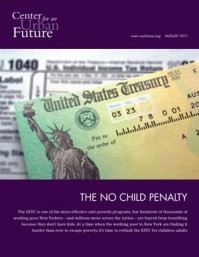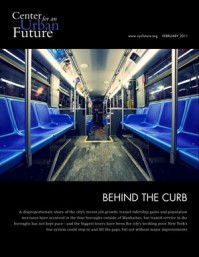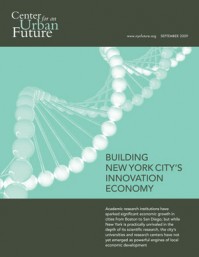Report - August 2011
The No Child PenaltyOur new policy brief shows that while growing numbers of working New Yorkers without kids are struggling to get out of poverty, the federal government's main anti-poverty program—the Earned Income Tax Credit (EITC)—almost exclusively benefits tax filers with children. The report reveals that hundreds of thousands of low-income working people in New York—and millions more around the nation—are effectively barred from receiving benefits from the EITC, while the relatively few who do qualify receive extremely small credits.
Report - June 2011
End of an ARRAThe 2009 federal stimulus brought a huge infusion of funds to New York City for job training and workforce development, but the money is now running out. This report looks at how the funds were spent and what the end of this funding stream means at a time when countless New Yorkers are still out of work.
Report - June 2011
Growth by DesignThis report details the powerful economic impact of New York's architecture and design sectors. It shows that New York has far more designers than any other U.S. city, but concludes that far more could be done to harness the sector's growth potential.
Report - May 2011
Staten Island: Then and NowBetween 1990 and 2010, no other borough changed as much as Staten Island. This report shows just how the borough has been transformed, with more than 80 graphs and charts detailing trends in demographics, the economy, development, commuting and education
Report - March 2011
Giving Small Firms the BusinessOur survey of nearly 200 small businesses shows that becoming a corporate supplier typically leads to significant revenue and job growthbut breaking into the corporate supply chain is a huge challenge for many small firms.
Report - February 2011
Behind the CurbThis report finds that a disproportionate share of the city's recent job growth, transit ridership gains and population growth have occurred in the four boroughs outside of Manhattan, yet transit service in the boroughs has not kept pace-and the biggest losers have been the city's working poor. We argue that New York's bus system could step in and fill the gaps, but not without major improvements.
Report - February 2011
Pathway to ProsperityNew York's Career Pathways initiative represents a significant step forward for workforce development in the city; while there is room for improvement, it breaks ground by going beyond short-term job placements and focusing on getting low-income individuals the skills to obtain decent paying careers.
Report - January 2011
Subsidizing Care, Supporting WorkThis report finds that the supply of subsidized child care in NYC has slipped in recent years even as affordable child care has become increasingly critical for low-income parents to get and hold jobs or complete a postsecondary degree.
Report - December 2010
A Chain ReactionOur third annual ranking of national retailers in NYC finds that despite the sluggish economy, the 280 national retailers listed in our 2009 report now have 4.1 percent more stores in the city than a year ago, with every borough registering a net increase in this period. Brooklyn had the largest net gain of any borough. And, for the third year running, Dunkin Donuts comes in as the national retailer with the most stores in the city.
Report - October 2010
Time to be CreativeThis report argues that the sharp downturn in New York City's real estate market presents a unique opportunity to address the serious space needs of the city's artists, arts groups and creative entrepreneurs. It includes 17 recommendations for taking advantage of the downturn to strengthen New York's creative sector.
Report - September 2010
Breaking into the Corporate Supply ChainThis new report reveals that strikingly few small businesses become suppliers to the nation's largest corporations but argues that helping more of them make this leap could give small firms a much-needed boost and help spark an economic recovery.
Report - June 2010
New Visions for New York Street FairsNew York City street fairs need a makeover. But just what should be done to improve these much-maligned staples of summer? This report features the visions of 25 architects, urbanists, artists, developers and other innovative thinkers, including the founders of successful public markets like the New York City Greenmarket, Union Square Holiday Market and Brooklyn Flea, as well as the creator of Chowhound.com, the organizer of Red Hook Food Vendors and musician David Byrne.
Report - March 2010
An Action Agenda for ESOLThis concept paper written by the Center for an Urban Future and the Schuyler Center for Analysis and Advocacy includes eight recommendations for supporting and strengthening the state's English for Speakers of Other Languages (ESOL) programs. The action agenda, which was endorsed by an unusual coalition of the state's leading business groups, immigrant advocates, literacy providers and workforce training professionals, calls on New York policymakers to guarantee level funding for state-run ESOL programs even in this difficult fiscal environment. It argues that supporting ESOL programs is increasingly important to New York's economic competitiveness since immigrants represent the fastest-growing part of the workforce in nearly every corner of the state.
Report - February 2010
Energizing New York’s Small BusinessesThis report reveals that only a fraction of the city's small businesses have taken steps to become energy efficient, a missed opportunity given that commercial electricity costs here are among the highest in the country and since even the smallest firms could save thousands of dollars by implementing efficiency measures. We detail why so few companies have taken advantage of conservation programs and recommend how to get more firms to take the plunge.
Report - January 2010
Closing the Skills GapThis report, jointly published by CUF and the Community Service Society, finds that New York City faces a human capital crisis that could threaten the city's long-term economic competitiveness while relegating countless residents to low-wage jobs. It shows that an alarming number of New Yorkers now lack the skills and educational credentials to compete in today's economy and warns that the problem will only get worse in the years ahead. The report calls for a comprehensive campaign to develop the skills of New York's population.
Report - December 2009
Low-Wage JobsThis edition of New York by the Numbers reveals that nearly a third of all adult workers in New York City are employed in low-wage jobs. While the percentage of low-wage workers is high across the city, the Bronx is in a league of its own, with 42 percent of the borough's workers in low-wage jobs.
Report - September 2009
Building New York City’s Innovation EconomyThis report finds that New York City's leading universities and scientific research centers have not become catalysts for entrepreneurship and local economic development the way similar institutions have in other regions. It argues that this is a huge missed opportunity for New York, given the need to diversify the economy and create new engines of job growth. The study details why New York is falling short, showing that university leaders have not done enough to support start-up ventures.
The report is accompanied by the city's first-ever "Innovation Index," a package of 49 charts and graphs that show where New York stands compared to other cities and regions on a broad range of indicators measuring both existing science and technology assets and the city's level of success at commercializing these assets.
Report - August 2009
Return of the ChainsOur second annual ranking of national retailers in New York City finds that over 30 percent of the retailers from last year's report actually expanded their presence in the city in the past year, despite the sour economy. Dunkin' Donuts tops our list for the second straight year, with a staggering 429 stores. The list includes a breakdown of 277 national retailers that have two or more stores in NYC, broken down by every borough and zip code.
Report - July 2009
Six Months Later: What Has President Obama Done for New York City?A week before President Obama took office, the Center for an Urban Future published a report that laid out 51 specific recommendations for what the Obama administration and the 111th Congress could do to help New York City and other cities. Now, at the six month anniversary of President Obamas inauguration, we are taking a close look at which of these 51 recommendations have been achieved. Our conclusion: While the administration still has a long way to go to create a comprehensive national urban policy, it has already made an extraordinary amount of progress on issues that matter to New York and other cities.
Report - June 2009
Manhattan’s Declining Share of New York City JobsThis edition of New York by the Numbers shows that over the last 50 years, Manhattan has been gradually loosening its grip on the private sector jobs in New York City. In 1958, the borough accounted for 67.6 percent of all non-government jobs in the city. But by 2008 its share had fallen six percentage points to 61.6 percent. The other four boroughs, meanwhile, have experienced a slow but steady increase in their share of jobs.





















